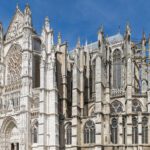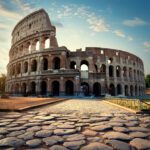Croatia – everyone knows about the marvelous coast of this country…considered one of the most beautiful in the world. But I wanted to see what else the country had to offer. After driving 1900 kms in six days, I can honestly say that there is an astonishing wealth of interesting archaeological and historical sites…..
Day 4 – Šibenik’s Church of St. James is another UNESCO World Heritage Site. Dominating this charming medieval town, the church exterior is decorated with marvelous sculpted faces of the local citizens. After an outstanding meal in a local restaurant, a friend drove us to Bibich winery where we spent an hour tasting delectable wines. Have I told you that Croatia produces fabulous wines? Yum! I mean really delicious, outstanding wines.
Day 5: Of course, we couldn’t visit Croatia and not see at least one of the country’s famous islands. Our choice was Hvar – the long, narrow piece of land protecting the mainland south of Split. Again we traveled by ferry and then drove through the Stari Grad Plain where fields were first created by Greek colonists in the 4th century BC and still remain in use today. Our destination was the exquisite town of Hvar. Here, the central plaza faces the picturesque harbor and is encircled on three sides by the church, the stone mansions of former nobility, and one of the first public theaters in Europe. We strolled through this charming village, (and ok, did some shopping) and then had the good fortune of visiting the convent to see lace created by the nuns out of agave thread.
Day 6: We have been trying to get a grasp on the Balkan history – whew! Very convoluted and complicated – Croats, Serbs, Bosnians, Ottomans – all converging in this small area. I definitely need to do some research when I return home. Today was very special. We first of all saw Ston where an entire mountain top has been fortified. What incredibly impressive walls! We then drove to the tiny village of Vid, located on the Bosnia-Herzegovina border. Today’s town covers the ancient Roman city of Narona. During excavations in 1995, the archaeologists uncovered a Roman temple with statues of the emperors Claudius and Vespasian, as well as two of Augustus and his wife Livia lying where they had fallen in antiquity on the sanctuary’s mosaic floor. The superb modern museum created to exhibit the artifacts found onsite, has grated floors with the excavated city walls visible below. Now on to Dubrovnik…
Day 7: Dubrovnik, ahhh, Dubrovnik. Words can not paint a true picture of this fascinating, gorgeous, fortified city with its 17th and 18th century Renaissance buildings crowned by red-tiled roofs. The city walls are incredible – 12-16 feet thick on the land side and almost a mile around the city. We walked the walls and enjoyed both the views into the city and towards the sea. Beautiful, beautiful!



